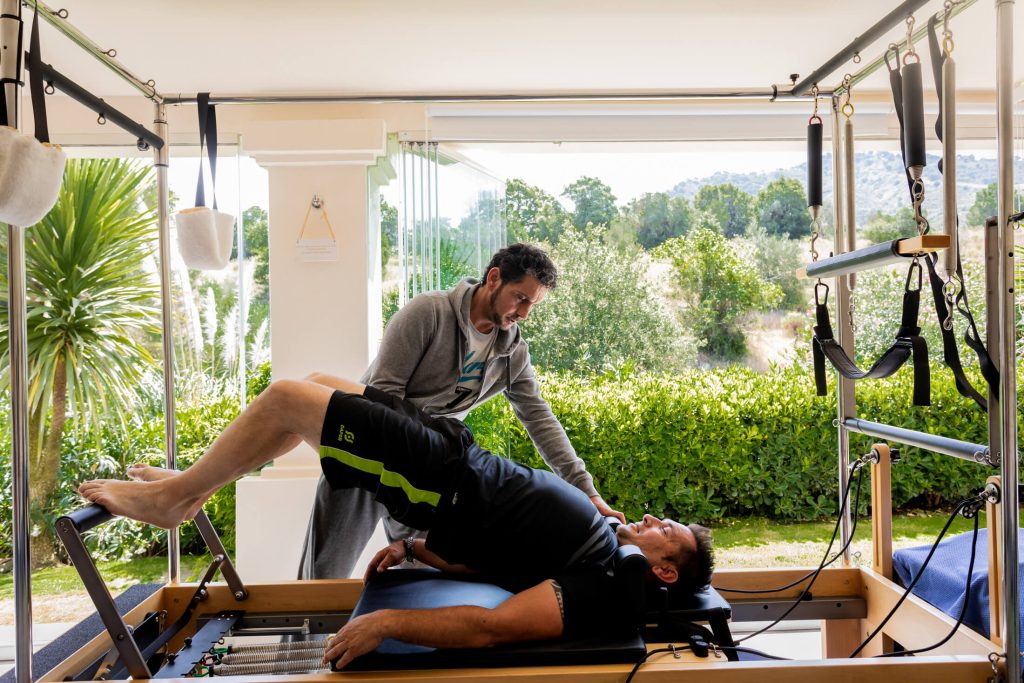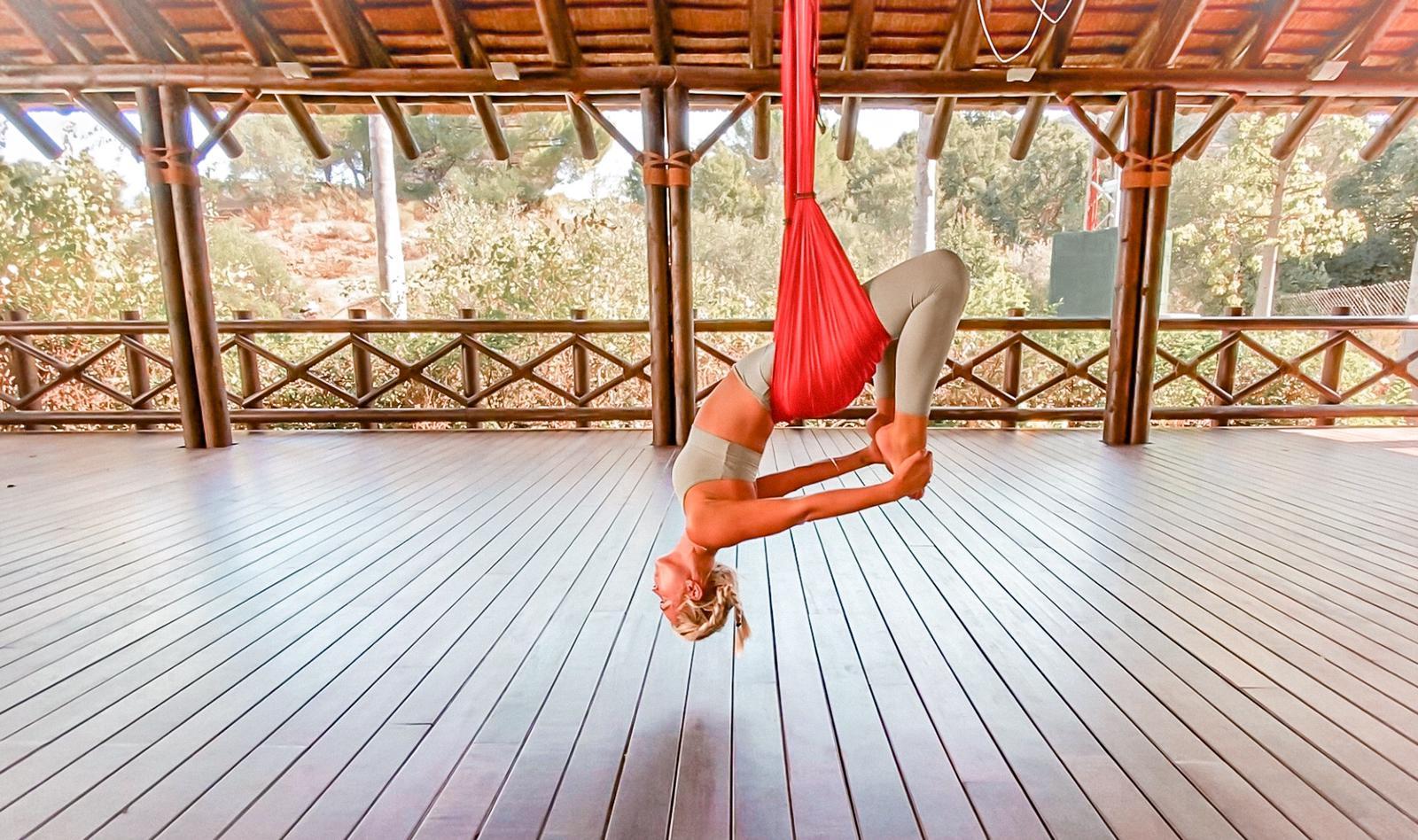The Complete Guide to a Pilates Workout
A Pilates workout is all about slow, controlled movements—but its fitness and health rewards are supercharged. Whether you go for a class on a mat, use gravity for resistance like Aerial Pilates, choose a reformer machine or a more contemporary variation with equipment like spring-loaded chairs, you’ll walk away with feel-better benefits on day one.
At Shanti-Som we are one of the few Wellness Retreats that offer a Pilates focused program. We have seen our Pilates classes gaining more popularity as guests immediately feel the benefits of increased muscle strength, tone and improved ‘core’ strength in the abdomen and lower back. This means moving around in day-to-day activities becomes easier and more fluid. Pilates is a more focused physical workout, and a lot of fun, especially as you start to experiment with different equipment that works on muscles you never realised you had!
Our Fitness Coach at Shanti-Som discusses everything you need to know about a Pilates workout, benefits and how it is different to Yoga.
What is the difference between a Yoga and Pilates Workout?
Yoga and Pilates share many qualities and benefits. In fact, many people see these as complementary practices and choose to do both for optimal mental and physical fitness. The major difference between Pilates and Yoga is that in addition to mat work, there can be different exercise machines involved.
Pilates uses fewer, more precise movements in order to achieve the Pilates principles of correct alignment, centering, concentration, control, precision, breathing, and flow. Pilates advocates the core-strengthening benefits of the method to improve posture and balance. Pilates targets the “powerhouse” muscles, which include the glutes, hips, pelvic floor, and lower back. Similar to Yoga, the Pilates Method encourages deep, conscious breathing whilst being a low intensity workout that has extensive benefits for overall improved mobility.
Through repetitive movement, Yoga focuses on flexibility and broad muscle groups while proving to be extremely therapeutic with many mental and physical health benefits. Many types of Yoga involve meditation and deep breathing, which aids in relaxation. The meditative portion of Yoga tends to attract people who are seeking to take it easy and de-stress.
How to Choose between Yoga or Pilates Workout
Depending on your personal goals will determine which practice is best for you.
- Pilates exercises are a lot more intense and results may be noticed much quicker than Yoga. Through frequent Pilates exercises, a flatter and firmer stomach may be easier to obtain.
- Pilates may be slightly better than Yoga for improving strength, particularly core strength, because it often uses an external stimulus, such as the reformer, whereas yoga uses your own body weight.
- Yoga might be the most effective exercise to combat depression or anxiety because it focuses on the mind as well as the body. In Yoga, the breathing exercises help you to achieve relaxation because you have to concentrate on how the breath is being employed. Sending your breath to specific problem areas that are holding stress can help relax these muscle groups in your body.
- Yoga is better for building flexibility. The poses are really about stretching your muscles and creating a little bit more space in your body.
- If you’re trying to lose weight, how many calories you burn while exercising matters. The calories you burn during Yoga and Pilates will depend on the type you practice.
For example, the American Council on Exercise found 50 minutes of:
- Hatha yoga burned 144 calories
- Power yoga burned 237 calories
- Beginner Pilates burned 175 calories
- Advanced Pilates burned 254 calories

Pilates Principles
Core strength is the foundation of how Pilates works. Strengthening the core develops stability throughout the entire torso. This is one of the ways Pilates helps many people alleviate back pain.
Trunk stability through core engagement is the most important aspect of Pilates training since it dictates how the body moves, not just in the studio or gym but in daily life. The goal is to create a body that moves with grace, ease, and efficiency. Such a body has to be both strong and flexible, and it has certain qualities of movement, such as being centered and balanced, fluid yet controlled.
There are six principles of Pilates. They summarize the philosophy of the Pilates method and are essential to getting the most out of every exercise:
- Centering: This is the practice of bringing your awareness to the center of your body—the area between the lower ribs and pubic bone. This central region of the core powers all Pilates exercises.
- Concentration: By focusing on each exercise with your full attention, you will yield maximum results from each movement.
- Control: Complete muscular control requires conscious, deliberate movement and is emphasized in every Pilates exercise.
- Precision: Sustained awareness ensures that each movement is precise. This means the appropriate placement of each body part, and focusing on proper alignment and core engagement.
- Breath: Joseph Pilates, the founder of Pilates, advocated for using the lungs to strongly pump the air fully in and out of the body. Most Pilates exercises coordinate with the breath since the breath is integral to the method.
- Flow: Pilates exercises are not meant to be rigid. Fluidity, grace, and ease are applied to every movement. The idea is that the energy of an exercise performed from the central “powerhouse” connects each part of the body to move in a single fluid motion. Pilates equipment such as the reformer is a great indicator of flow since it functions best when a practitioner is performing movements with both precision and fluidity.
What is Reformer Pilates Workout
Reformer Pilates is a form of exercise that shares the principles of centering, concentration, control, precision, breath and flow with traditional mat classes, but is done on a reformer machine.
The machine consists of a seat on a track, attached to springs for resistance and outfitted with ropes and bars for balance and alignment. When performing exercises, the machine keeps the body in the correct position, providing tactile feedback to help us know when we’re in the right spot and hitting the right muscles.
The resistance created by the pulley and spring system can provide a more challenging strength and endurance workout than mat classes. It may also produce visible results sooner — arm, leg, and abdominal muscles can look firmer and defined within a dozen or so regular sessions.
If you are trying to lose weight, Pilates exercises can be done using a Reformer Machine that add cardio to your poses. This can help you to burn additional calories.
Who Should do Reformer Pilates?
The Reformer Pilates machine can look a bit overwhelming for beginners. But once you get familiar with how it works we promise you’ll enjoy how it guides your body to feel in control of each movement. In no time you’ll be feeling like an acrobat swinging from the bars like a pro.
Reformer Pilates a great place to start whatever your level of fitness. All the exercises can be progressed and regressed to the individual being taught. This will enable you to be challenged, thus strengthening you in multiple ways and setting you up to achieve your fitness goals.
From rehab clients that needs the support of the springs to enhance their recovery, to desk workers that sit too much and pro athletes. Reformer Pilates is complementary to all lifestyle
Aerial Pilates
Historically, Aerial Arts were exclusively taught within the circus arena. However, more recently, modern circus inspired by Cirque du Soleil has adopted many aerial techniques, which has brought this exquisite art to a larger audience. Aerialists use many different Pilates based methods to train and condition their bodies for gravity-defying circus performances. Aerial Pilates was born because many people loved the fitness benefits of Aerial training without the desire to become an Aerialist.
Aerial Pilates is a fusion of Pilates and Aerial Silks. Aerial workouts are performed with the assistance of an aerial silk or hammock/swing suspended from the ceiling – but typically only a few inches off the ground. Participants sit, lie, stand, climb and hang from the swing in a variety of poses designed to lengthen and strengthen the body. Although it can be a little bit intimidating to climb into the swing for the first time, these props are constructed out of high-density nylon and intended to support over 1000 pounds. Strong ropes and carabiners ensure that the swing (and handles, if applicable) are safely secured to the support system of the building and the entire set-up is completely safe
Aerial Pilates is a fun, challenging workout that introduces anti-gravity benefits such as decompression of the spine and joints, increased stretching and elongation and core strength building. Drawing various elements from flexibility training, yoga, strength training as well as aerial arts; it’s not only a fun way to lose weight and stay fit, but also a great training tool for athletes particularly those in need of rehabilitation.
Everyone is different, and some people may be able to gain balance faster than others, however with a little work, most people gain their balance within the first session. The benefits are worth a bit of perseverance and you’ll leave feeling a sense of wild achievement.

Conclusion on Pilates Workout
We think a combination of Yoga and Pilates movement is a great way to exercise body and mind for a holistic approach to a healthy lifestyle. At Shanti-Som we encourage our guests to try the Reformer Pilates machine as well as Aerial workouts with the guidance of our Fitness Trainer to see how easy and fun it is to use, plus you’ll feel instant results.
If you are interested in a Pilates Retreat please contact us or we can create a bespoke program with a mixture of Yoga and Pilates movement.

